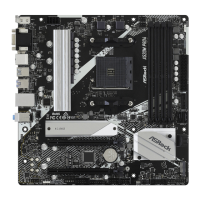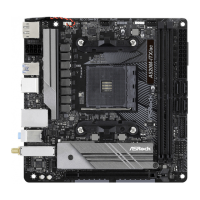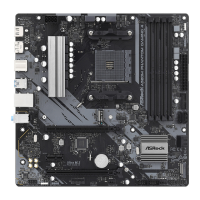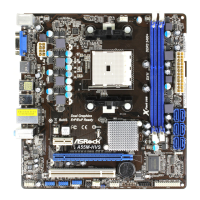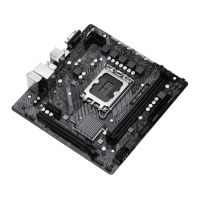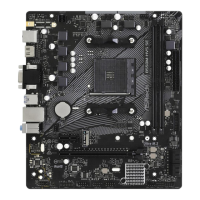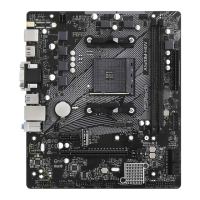
Do you have a question about the ASROCK A520M HVS and is the answer not in the manual?
| Processor socket | Socket AM4 |
|---|---|
| Processor manufacturer | AMD |
| Compatible processor series | AMD Ryzen 3 3rd Gen, AMD Ryzen 5 3rd Gen, AMD Ryzen 7 3rd Gen, AMD Ryzen 9 3rd Gen |
| Non-ECC | Yes |
| Memory channels | Dual-channel |
| Memory slots type | DIMM |
| Number of memory slots | 2 |
| Supported memory types | DDR4-SDRAM |
| Maximum internal memory | 64 GB |
| Supported memory clock speeds | 2133, 2400, 2666, 2933, 3200, 3466, 3600, 3733, 3800, 3866, 4000, 4133, 4200, 4266, 4333, 4400, 4466, 4500, 4533 MHz |
| Number of HDDs supported | 5 |
| Supported storage drive interfaces | M.2, SATA III |
| Graphics card | Radeon Vega |
| Parallel processing technology support | - |
| USB 3.2 Gen 1 (3.1 Gen 1) connectors | 1 |
| USB 3.2 Gen 2 (3.1 Gen 2) connectors | 0 |
| USB 2.0 ports quantity | USB 2.0 ports have a data transmission speed of 480 Mbps, and are backwards compatible with USB 1.1 ports. You can connect all kinds of peripheral devices to them. |
| USB 3.2 Gen 1 (3.1 Gen 1) Type-A ports quantity | 4 |
| Wi-Fi | No |
| LAN controller | Realtek RTL8111H |
| Ethernet interface type | Gigabit Ethernet |
| Component for | PC |
| Motherboard chipset | AMD A520 |
| Audio output channels | 7.1 channels |
| Motherboard form factor | micro ATX |
| BIOS type | UEFI AMI |
| Cables included | SATA |
| Harmonized System (HS) code | 84733020 |
| Depth | 201 mm |
|---|---|
| Width | 230 mm |
Lists all items included in the motherboard package.
Details the technical specifications of the motherboard, including platform, CPU, chipset, memory, and expansion slots.
Illustrates and labels the physical components and connectors on the motherboard.
Describes the ports and connectors available on the motherboard's rear I/O panel.
Provides essential safety guidelines to follow before installing hardware components.
Step-by-step guide on how to properly install the CPU into the motherboard socket.
Instructions for attaching the CPU cooler and heatsink for effective heat dissipation.
Guidance on installing DDR4 DIMM memory modules into the motherboard slots.
Explains the usage and installation for PCI Express x1 and x16 slots.
Details how to set up jumpers, specifically for clearing CMOS.
Explains how to connect system panel headers, SATA, USB, and audio connectors.
Step-by-step instructions for installing M.2 SSD modules.
Guide on installing essential drivers from the support CD.
Explains how to install and use the ASRock A-Tuning software for system monitoring and control.
Details on using the ASRock APP Shop for software updates and downloads.
Describes the layout and sections of the ASRock APP Shop interface.
Instructions for finding, downloading, and installing applications via the APP Shop.
Guide on how to update BIOS and drivers using the ASRock APP Shop.
How to configure language, server location, and auto-run settings for the APP Shop.
Overview of how to access and navigate the UEFI BIOS setup utility.
Explains the main menu options available in the UEFI setup utility.
Lists keyboard shortcuts and controls for navigating the UEFI setup utility.
Displays the system overview and basic information upon entering the UEFI setup.
Configuration options for overclocking system components like CPU and memory.
Access to detailed system configurations, including CPU, devices, storage, and ACPI.
Detailed settings for CPU features like PSS Support, NX Mode, SVM Mode, and SMT Mode.
Configuration for onboard devices like HD Audio, LAN, and USB ports.
Settings related to SATA modes (AHCI/RAID) and hot-plug functionality.
Configuration for ACPI power saving features like Suspend to RAM and Deep Sleep.
Configuration for Super IO devices such as serial ports.
Settings for BIOS support of security devices.
Access to AMD-specific features and configurations.
Options for configuring CPU frequency and voltage for overclocking.
Access to AMD Chipset common options and miscellaneous controls.
Tools for RAID installation, SSD secure erase, NVME sanitization, and BIOS flashing.
Monitors system hardware status, including CPU/motherboard temperatures, fan speeds, and voltages.
Settings for managing supervisor/user passwords and enabling Secure Boot.
Configures boot settings, boot priority, and CSM options.
Options for saving changes, discarding changes, and loading default BIOS settings.



